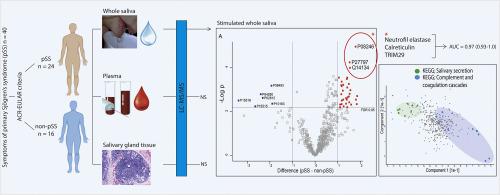Journal of Proteomics ( IF 2.8 ) Pub Date : 2020-06-12 , DOI: 10.1016/j.jprot.2020.103877 Maria L Sembler-Møller 1 , Daniel Belstrøm 2 , Henning Locht 3 , Anne Marie L Pedersen 1

|
Objective
The aim of this study was to characterize and compare the proteome in whole saliva, plasma, and salivary gland tissue in patients with primary Sjögren's syndrome (pSS) and patients having symptoms of pSS, but not fulfilling the classification criteria, and to search for diagnostic biomarker candidates for pSS.
Methods
Liquid chromatography tandem mass spectrometry was conducted on whole saliva, plasma, and labial salivary gland tissue samples from 24 patients with pSS and 16 non-Sjögren control subjects (non-pSS). Gene Ontology (GO)-terms and Kyoto Encyclopedia of Genes and Genomes (KEGG)-pathways were applied for functional annotation.
Results
1013 proteins were identified in whole saliva, 219 in plasma, and 3166 in salivary gland tissue. In saliva, 40 proteins differed significantly between the two groups. In pSS, proteins involved in immunoinflammatory processes were upregulated, whereas proteins related to salivary secretion were downregulated. The combination of neutrophil elastase, calreticulin, and tripartite motif-containing protein 29 yielded a receiver-operating characteristic (ROC) value of 0.97 (CI 0.93–1.00). Protein expression in plasma and salivary gland tissue did not differ between the patient groups.
Conclusion
The salivary proteome of patients with pSS differed from that of non-pSS patients, indicating that saliva proteomics represents a promising non-invasive diagnostic tool for pSS.
Significance
Primary Sjögren's syndrome (pSS) is a chronic systemic autoimmune disease, which clinically may present with a wide variety of symptoms and signs. Symptoms of dry eyes and dry mouth due to lacrimal and salivary gland dysfunction are prominent, but not pathognomonic, and an extensive diagnostic work-up including blood tests and labial salivary gland biopsy is often required to distinguish pSS from non-pSS. In this study, we used high throughput proteomics and identified a non-invasive biomarker candidate comprising a combination of three different upregulated salivary proteins, which enables differentiation between patients with pSS and non-pSS patients with an accuracy of 97%. In the future, this could contribute to earlier, more accurate and less costly diagnosis of pSS.
中文翻译:

干燥综合征和非干燥综合征患者的唾液,血浆和唾液腺组织的蛋白质组学可以确定新型的生物标志物候选物。
目的
这项研究的目的是表征和比较患有原发性干燥综合征(pSS)的患者和有pSS症状但不符合分类标准的患者的唾液,血浆和唾液腺组织中的蛋白质组,并进行诊断pSS的生物标志物候选物。
方法
液相色谱串联质谱法是对来自24名患有pSS的患者和16名非Sjögren对照受试者(非pSS)的整个唾液,血浆和唇唾液腺组织样本进行的。将基因本体论(GO)术语和《京都议定书》的基因与基因组百科全书(KEGG)途径应用于功能注释。
结果
在整个唾液中鉴定出1013种蛋白质,在血浆中鉴定出219种,在唾液腺组织中鉴定出3166种蛋白质。在唾液中,两组之间的40种蛋白质差异显着。在pSS中,与免疫炎症过程有关的蛋白质被上调,而与唾液分泌有关的蛋白质被下调。中性粒细胞弹性蛋白酶,钙网蛋白和包含三重基序的蛋白质29的组合产生的受体操作特征(ROC)值为0.97(CI 0.93-1.00)。两组患者血浆和唾液腺组织中的蛋白表达没有差异。
结论
pSS患者的唾液蛋白质组与非pSS患者的唾液蛋白质组不同,这表明唾液蛋白质组学代表了有希望的pSS非侵入性诊断工具。
意义
原发性干燥综合征(pSS)是一种慢性全身性自身免疫性疾病,临床上可能表现出多种症状和体征。泪腺和唾液腺功能障碍引起的干眼症和口干症症状很明显,但并非病理症状,因此通常需要进行广泛的诊断检查,包括血液检查和唇唾液腺活检,以区分pSS与非pSS。在这项研究中,我们使用了高通量蛋白质组学技术,并鉴定了包含三种不同上调唾液蛋白的组合的非侵入性生物标志物候选物,从而能够以97%的准确度区分pSS患者和非pSS患者。将来,这可能有助于pSS的更早,更准确和更便宜的诊断。











































 京公网安备 11010802027423号
京公网安备 11010802027423号